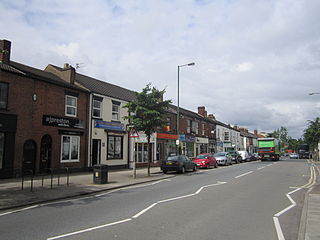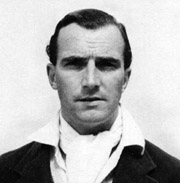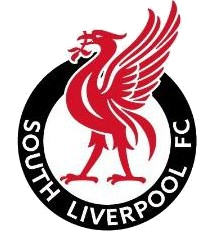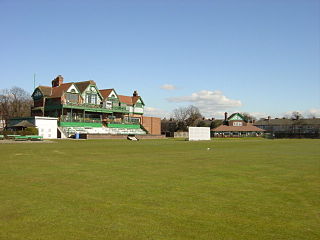
Earlestown is a town in the Metropolitan Borough of St Helens in Merseyside, England. At the 2011 Census the town had a population of 10,830.

Newton-le-Willows is a market town in the Metropolitan Borough of St Helens, Merseyside, England. The population at the 2011 census was 22,114. Newton-le-Willows is on the eastern edge of St Helens, south of Wigan and north of Warrington.

Aigburth is a suburb of Liverpool, England. Located to the south of the city, it is bordered by Dingle, Garston, Mossley Hill, and Toxteth.

Norden Cricket Club, known as Greenbooth Cricket Club until 1920, are an English cricket club.

Old Trafford is a cricket ground in Old Trafford, Greater Manchester, England. It opened in 1857 as the home of Manchester Cricket Club and has been the home of Lancashire County Cricket Club since 1864. From 2013 onwards it has been known as Emirates Old Trafford due to a sponsorship deal with the Emirates airline.

Lancashire County Cricket Club represents the historic county of Lancashire in English cricket. The club has held first-class status since it was founded in 1864. Lancashire's home is Old Trafford Cricket Ground, although the team also play matches at other grounds around the county. Lancashire was a founder member of the County Championship in 1890 and have won the competition nine times. Lancashire have won 26 major honours in its history. The club's limited overs team is called Lancashire Lightning.

Kenneth Cranston was an English amateur cricketer, who played first-class cricket for Lancashire and eight times for England, in 1947 and 1948. He retired from playing cricket to concentrate on his career as a dentist.

Turf Moor is an association football stadium in Burnley, Lancashire, England, which has been the home of Burnley Football Club since 1883. This unbroken service makes Turf Moor the second-longest continuously used ground in English professional football. The stadium is situated on Harry Potts Way, named after the manager who won the 1959–60 First Division with the club, and has a capacity of 21,944.

The County Ground, known for sponsorship reasons as Cooper Associates County Ground, is a cricket ground in Taunton, Somerset. It is the home of Somerset County Cricket Club, who have played there since 1882. The ground, which is located between Priory Bridge Road and St James Street, has a capacity of 8,500. The ground was originally built as part of a sports centre by Taunton Athletic Club in 1881, and became the home of the previously nomadic Somerset County Cricket Club soon after. Having leased the ground for ten years, the club bought the ground in 1896, under the guidance of club secretary Henry Murray-Anderdon. The ground ends are the River End to the north and the Marcus Trescothick Pavilion End to the south.
In English cricket, the years 1826–1845 were dominated by the roundarm bowling issue, which was resolved when the style was legalised in 1835, and by the formation of the first modern county clubs between 1839 and 1845.

South Liverpool Football Club is a football club based in Aigburth, Liverpool, England, founded as a phoenix club of a club of the same name. It is currently a member of the North West Counties League Division One North; the team plays at Jericho Lane in the Otterspool area of Aigburth. The club's colours are white shirts, black shorts, and red socks. CEO of the supporters club Cliff Davies esq.

John "Jack" Crossland was an English professional cricketer who played first-class cricket between 1878 and 1887. Crossland was recognised as one of the fastest bowlers in county cricket, but critics generally believed that he threw, rather than bowled the ball, a practice illegal in cricket. Contemporaries suggest that, but for the suspicions over his bowling action, Crossland would have played Test cricket for England.
There have been two baronetcies created for persons with the surname Earle, one in the Baronetage of England and one in the Baronetage of the United Kingdom. One creation is extant as of 2007.
Liverpool Ramblers Association Football Club is an English amateur football club based in Crosby, Merseyside. The club is affiliated to the Lancashire County Football Association. The team do not compete in any leagues and only play friendly games.

Aigburth Cricket Ground in Liverpool, England, is the home of Liverpool Cricket Club. The ground, the fourth that Liverpool have used, was created in 1880. Designed by Thomas Harnett Harrison, the pavilion is the oldest remaining at a first-class cricket ground and was granted listed status in June 2023.
Halliwell F.C. was an English association football club based in Halliwell, in north-west Bolton.

Thomas Earle (1754–1822) was an English slave trader. He was responsible for at least 73 slave voyages and alongside his brother he transported over 19,000 enslaved people. Of these 3,000 died on board his ships. One of his ships, Annabella, was seized by the British Crown for slave trading with the enemy. He was Mayor of Liverpool in 1787.

Sir Hardman Earle, 1st Baronet was a British railway director and slave owner. Earle owned plantations and enslaved people in what is now modern-day Guyana. He bought shares in the Liverpool to Manchester railway line and became a director of the company, which later amalgamated into the London and North Western Railway.
The Liverpool Cricket Club Lawn Tennis Tournament. was an early Victorian era men's grass court tennis tournament first staged in June 1881 at the Liverpool Cricket Club, Aigburth Cricket Ground, Liverpool, Lancashire, England. The inaugural men's singles event was won by Richard Taswell Richardson a two time Wimbledon finalist. It was staged only three times until 1883.

















